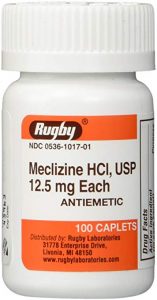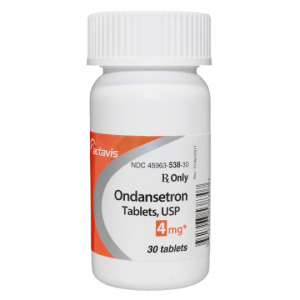The Most Common Antiemetic Drugs
The Most Common Antiemetic Drugs
The Most Famous 2 drugs for Antiemetic are:
1- Meclizine💊
2- Ondansetron 💊
Meclizine
- Brand Names: Dramamine
- Therapeutic Category: Antiemetic Drugs; Histamine H1 Antagonist
- Dosage Forms: Oral Tablet
- Use: Labeled Indications: Motion sickness/ Vertigo
- Dosing : Adult: Motion sickness: Oral: 25 to 50 mg 1 hour before travel, repeat dose every 24 hours if needed
- Vertigo: Oral: 25 to 100 mg daily in divided doses
- Pediatric:Motion sickness: Children ≥12 years and Adolescents: Oral: 25 to 50 mg 1 hour before travel, repeat dose every 24 hours, if needed
- Vertigo: Children ≥12 years and Adolescents: Oral: 25 to 100 mg/day in 3 or 4 divided doses
- Dose Adjustments
- Renal Impairment:. No dosage adjustment.
- Hepatic Impairment: No dosage adjustment.
- Adverse Drug Interaction:
Headache/ fatigue/ Drowsiness / Vomiting/ xerostomia - Pharmacodynamics/Kinetics:
- Onset of action: 1 hour
- Time to peak: plasma: 3.1 ± 1.4 hours
- Duration: 24 hours
- Half-life elimination: 5.2 ± 0.8 hours
- Important Notes:
- May cause CNS depression, which may impair physical or mental abilities; patients must be cautioned about performing tasks which require mental alertness
- Inappropriate medication to be avoided in patients 65 years and older (independent of diagnosis or condition) due to its potent anticholinergic properties resulting in increased risk of confusion, dry mouth, constipation
- Pregnancy & Lactation: Risk Factor B / not known if present in breast milk
- Drug safety issue:
Antivert may be confused with Anzemet, Axert
Ondansetron
- Brand Names: Zofran
- Therapeutic Category: Antiemetic Drugs
- Dosage Forms: Oral Tablet/ Solution, Injection
- Use: Labeled Indications: Cancer chemotherapy-induced nausea and vomiting/ Postoperative nausea and/or vomiting/ Radiotherapy-associated nausea and vomiting
- Off-Label: Carcinoid syndrome-associated diarrhea, severe, refractory/
- Gastroparesis, symptomatic treatment of nausea and vomiting /
- Nausea and/or vomiting, acute, severe/ Postoperative nausea and vomiting, treatment or rescue therapy/ Pregnancy-associated nausea and vomiting, severe or refractory/ Vertigo-associated nausea and vomiting
- Dosing : Adult: Oral: 8 mg 3 times daily or8 mg twice daily for 3 days, followed by a maintenance dose of 4 to 8 mg/day for 4 to 12 weeks
- Pediatric IV: Infants ≥6 months, Children, and Adolescents: 0.15 mg/kg/dose; maximum dose: 16 mg/dose
- Dose Adjustments
- Renal Impairment:. No dosage adjustment.
- Hepatic Impairment: Severe impairment: IV: Day 1: Maximum daily dose: 8 mg
- Adverse Drug Interaction:
Headache/ fatigue/ Drowsiness /sedation / dizziness / agitation - Pharmacodynamics/Kinetics:
- Onset of action: 30 minutes
- Time to peak: Oral: 2 hours
- Bioavailability: Oral: 50% to 70%
- Half-life elimination: Adults: 3 to 6 hours
- Important Notes:
- Hypersensitivity: Hypersensitivity reactions (including anaphylaxis and bronchospasm) have been reported; discontinue if hypersensitivity occurs
- Pregnancy & Lactation: Risk Factor B / not known if present in breast milk
- Drug safety issue:
Ondansetron may be confused with dolasetron, granisetron, palonosetron
Zofran may be confused with Zantac, Zosyn
Read More
- Antimicrobial Stewardship School
- Sepsis Training Program
- Download Pocket Guide for Antibiotic Pharmacotherapy Book
- Microbiology Course | ABC Bacteria
- Infectious Disease E-News | FREE Subscription
- ABC antimicrobials | Know all about the Antimicrobials
- Road Map to Antimicrobial Stewardship Training Program
- Register Now in FADIC Clinical Research School
- FADIC Drug Information Fellowship
- Buy FADIC Toolkit for Writing Research to Write a Great Research Paper
- Read 10 Skills You Must Learn to Make a Research via Google Scholar in Arabic
- The FADIC Online Continuous Medical Improvement Programs & Mini-Courses.
- Check Now FADIC Book store and Buy books in different specialties.
- Watch Now FADIC TV to Keep your self Updated.
- FADIC Podcast focusing on varieties of pharmacist perspectives in different specialties.
- Subscribe Now in FADIC 2020 Daily News (FNN) and Keep Updated.
- Check Now about Coronavirus Resource Information Center.

 Log in
Log in Sign up
Sign up



